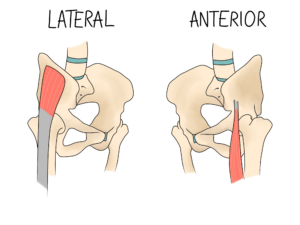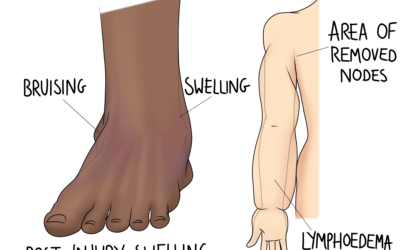Snapping hip syndrome is, as the name suggests, a condition in which a “snap” is heard or felt from the hip area on certain movements. Although this may initially be quite worrying, this is usually caused by a muscle flicking over a bone in the hip area. A few different muscles can be involved, and each group is considered as a different “type” of the syndrome. In some cases, the snap is caused by a problem with the cartilage, as detailed below.
The condition is commonly associated with sports, earning the nickname “dancer’s hip”. Any activity that requires repetitive hip movements can be associated. Links with football, cycling, and running are particularly well documented. The GHC team have three decades of experience working with dance schools, including the Northern School of Contemporary Dance, and Phoenix Dance Theatre. We are well versed in the diagnosis and management of these conditions among dancers, yogis, and more.

Lateral (or External) Snapping Hip
The lateral type involves the muscle that moves the leg out to the side: TFL (tensor fascia lata). You might be familiar with an associated structure: the IT Band. TFL blends into ITB and the two work closely together. ITB’s role is to stabilise the knee, but as it is not a contractile muscle itself, it is controlled by tension in the TFL. So if your knee is unstable, you might find that your TFL becomes tight and is more prone to “snapping”.
In this case, the snap itself comes from the tendon running over the greater trochanter. This is a protrusion of bone on the outer edge of the top of the thigh bone. When the overlying soft tissues become tight, they can simply snap over the bone on some movements. This may not be painful, just audible and palpable, but as these things rarely happen in isolation, it would be wise to investigate it further. Treatment can be very straight forward, using massage, mobilisation, exercises and advice to relax off the muscle responsible, and keep any underlying issues under control. Addressing problems before they become too symptomatic is a good plan to minimise your downtime from sports due to fully developed injuries.
Anterior Snapping Hip
In contrast, anterior type snapping hip comes from one of the quadriceps muscles: rectus femoris. This type is generally less recognised than the others, so you may find that it’s been harder for you to get a diagnosis if this is your ailment. Here the snap is caused by flexing (bending) and extending (straightening) the hip. Walking may not require a broad enough range to cause the snap, but sitting to standing and vice versa would likely be.
Some sources also mention a posterior type as a possibility. In this case, the hamstrings cause the snap, flicking over the sitting bone (ischial tuberosity) when flexing and extending the hip.
Internal Snapping Hip
A third type is not illustrated above. In this case, a muscle on the inner edge of the pelvis is involved. This is iliopsoas: a strong muscle that flexes the hip. It runs from the inside of the pelvis to the thigh bone. As it exits the pelvis, it can catch on one of the bumps at the front of the pelvis, causing the symptoms.
Iliopsoas makes up part of the abdominal wall, so unlike the other muscles, it’s very deep. Massage is more difficult, but not impossible, so your osteopath may focus more on stretching and indirect techniques to relax it. The muscle can be considered as two separate muscles, iliacus and psoas. Psoas has quite a reputation for tension, and some people find that they seem to hold their stress in the muscle. This leads to more tension, and more likelihood of developing a snap.
Cartilage Involvement
When the snap is caused by cartilage, it may not be formally diagnosed as snapping hip- there may be a more precise diagnosis instead. Your snapping may be more uncomfortable if cartilage is causing the sound. Although for some people, there will be no pain at all.
The hip joint is a ball and socket joint, and both components are covered with smooth cartilage. A lip of cartilage also extends from the socket to help stabilise the very mobile joint. This lip can be more vulnerable to injury than the rest of the cartilage, especially when subjected to repetitive movements. Dance and running could cause these, but so could falls and other trauma. On some movements, the injured cartilage may move in and out of place, causing the symptoms of snapping hip.
Osteoarthritis
Cartilage can also cause a grinding sensation or small click rather than a well defined “snap”. This is the case in osteoarthritis. Although the pathophysiology is different, it is still within your osteopath’s remit, and worth addressing at the first signs. There are common misconceptions about arthritis; patients often present with the idea that it’s just something you have to live with. In fact, the cartilage is still living tissue, and with the right help, it may even be able to heal to some degree. In any case, we aim to slow the progression. Cartilage is like a sponge due to its poor blood supply. By improving movement we can help to squash the waste products out of the tissue, and make room for nutrients to enter in their place.
In some cases of osteoarthritis, a flake of cartilage will come loose from the joint surface, and float in the fluid of the joint space. The term for this is a “loose body”. This can cause a repetitive click that may not always be reproducible as it moves into different areas of the joint. Alongside the noise, it can also cause pain and locking. Arthroscopy is one approach to resolving a loose body, but we know that arthroscopy for osteoarthritis in the knee is no better than sham surgery. Conservative management like osteopathy may be a better first resort. As always, we will look at the whole patient, not just the affected joint. Rehabilitating the local area: improving range of movement and muscle strength is important. But we also want to make sure that other issues are not overloading the joint in the first place. Is this hip subjected to more impact on walking due to an unusual gait? Does an ankle or knee issue require more movement from the hip? We assess the whole person to find and treat the root causes.
Further Complications
Left untreated, the irritation can lead to other conditions like bursitis. Bursae are fluid filled sacs found all over the body, sitting between common areas of friction. They minimise the friction of soft tissue that would otherwise rub on bone, but the bursae themselves can become inflamed if subjected to enough repeated pressure. Bursitis may be felt as a deep ache that is worse after rest, constantly present to some degree, and responsive to a cool compress if the bursa involved is close enough to the skin. It can be a relatively long term condition, as it takes a while for the inflammation and thickening of the bursa to subside once addressed.
Osteopathic Management for Snapping Hip
Your osteopath can help with the symptoms and their cause. This dual pronged approach aims to relieve you of your symptoms in the present, and prevent future episodes.
For muscular types, where snapping has not been present since childhood or adolescence, the cause is simple muscle tension. For adolescents currently suffering, it may still be down to simple tension, but this may be compounded by a current growth spurt. This does not make a younger patient any less appropriate for osteopathic treatment. Please be aware that patients under the age of 16 will need a parent or guardian present at their appointment.
For symptomatic relief, relaxing the involved muscle will be sufficient. But we want to look deeper than that, and understand what caused the tension in the first place. For internal snapping hip, where the muscle is a deep hip flexor, maybe the cause is a sedentary lifestyle. Advice for better ergonomics and exercises to prevent repeated build-up of tension would be a better long-term plan. If you think that your desk or car ergonomics play a role in your symptoms, it may be helpful for you to bring a picture of your current set up to your appointment so we can offer some guidance.
Lateral or external snapping hip might be caused by a different injury altogether. As explained above, this form is associated with the IT band. Knee instability is one potential cause of increased ITB tension. The knee may become unstable if any of its ligaments are compromised, such as from sports injuries or trauma. Although ligaments are slow to heal, we can help to keep the area as healthy as possible. We can also encourage the surrounding muscles to take on a stabilising role in a more sustainable way through targeted exercises.
As outlined above, we also have management strategies for cartilage involvement. In all cases, you can expect a detailed treatment plan, with exercises and advice to help you to keep improving at home. Click the link below to begin addressing your snapping hip.
Click here to make an appointment in Leeds for your snapping hip



0 Comments